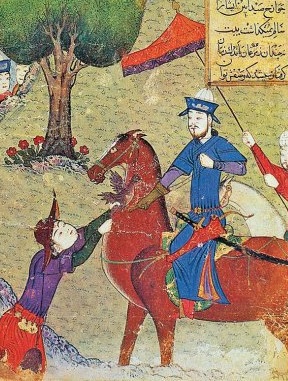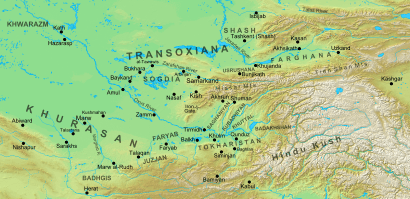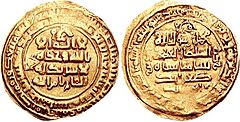Tughril facts for kids
Quick facts for kids Tughril |
|||||
|---|---|---|---|---|---|
| Bey | |||||
 |
|||||
| Sultan of the Great Seljuk Empire | |||||
| Reign | 1037 – 4 September 1063 | ||||
| Predecessor | Position established | ||||
| Successor | Alp Arslan | ||||
| Born | 990 | ||||
| Died | 4 September 1063 (aged 73) | ||||
| Spouse | Aka, daughter of Yusuf Qadir-Khan Altun Jan Khatun Seyyedeh Fatima |
||||
|
|||||
| House | Seljuk | ||||
| Father | Mikail of Kınık tribe | ||||
| Religion | Sunni Islam | ||||
Tughril Bey (Persian: طغرل بیک; 990 – September 4, 1063) was a powerful leader. He was a Turkoman who founded the Seljuk Empire. He ruled this empire from 1037 to 1063. Tughril brought together many Turkoman warriors. These warriors came from different tribes across the vast plains of Eurasia. They all believed they were related to a leader named Seljuk.
Tughril led these united tribes to conquer eastern Iran. He then created the Seljuk Sultanate. This happened after he took over Persia. He also recaptured Baghdad, the capital city of the Abbasid Caliphs, from the Buyids in 1055. Tughril made the Abbasid Caliphs more like symbolic leaders. He took control of their armies. He used these armies to fight against the Byzantine Empire and the Fatimids. His goal was to make his empire bigger and unite the Islamic world.
Early Life and Rise to Power

Tughril was the son of Mikail Beg. After his father died, Tughril and his brother Chaghri were raised by their grandfather, Seljuk. Tughril became a leader around the year 1016.
In the 1020s, Tughril and his relatives worked for the Kara-Khanids. This was a powerful group in Bukhara. In 1026, the Kara-Khanids were forced out of Bukhara. This was done by Mahmud of Ghazni, a Sultan from the Ghaznavids. Tughril and Chaghri stayed loyal to the Kara-Khanids for a while. They even fought with them in 1032.
Later, the Seljuks changed their loyalty. They joined the ruler of Khwarazm, Harun. But they were pushed back by another leader in 1035. The Seljuks then asked Mas'ud I, Mahmud's son, for a safe place to live. Mas'ud saw these nomadic Turks as a danger. He sent his army to fight them. But the Seljuks defeated Mas'ud's army. This forced Mas'ud to give them some lands. In return, the Seljuks would recognize his power and protect the area.
In 1037, the Seljuks also made the Ghaznavids give them more lands. The Seljuks then slowly began to take over cities in Khorasan. When they captured Nishapur, Tughril declared himself the Sultan of Khorasan. This was a big step in his rise to power.
Building the Seljuk Empire
After losing territory, Mas'ud returned to Khorasan. He pushed the Seljuks out of Herat and Nishapur. He then marched towards Merv to completely remove the Seljuk threat. His army was very large, with many soldiers and war elephants.
A major battle, the Battle of Dandanaqan, happened near Merv. Mas'ud's large army was defeated. It was beaten by a much smaller army led by Tughril, his brother Chaghri Beg, and a prince named Faramurz. This defeat meant Mas'ud lost control of all western Khorasan forever. This victory was very important. It marked the official start of the Seljuk Empire. The empire then began to grow very quickly towards the west.
Tughril made his brother Chagri the governor of Khorasan. This helped prevent the Ghaznavids from taking back the land. Tughril then moved on to conquer more areas in the Iranian plateau. This happened between 1040 and 1044. He conquered Tabaristan and Gurgan. He also took over Ray and Qazvin. Other local rulers also recognized his power.
By 1054, Tughril's forces were fighting in Anatolia against the Byzantines. In 1055, the Abbasid Caliph Al-Qa'im asked Tughril for help. He wanted Tughril to recapture Baghdad from the Buyids.
However, Tughril faced a challenge. His foster brother, İbrahim Yinal, started a rebellion. Also, the Buyid forces fought back. This led to Baghdad being lost to the Fatimid Caliph in 1058. But two years later, Tughril crushed the rebellion. He personally defeated İbrahim. Tughril then entered Baghdad again. He later married the daughter of the Abbasid Caliph.
Tughril's Legacy
Sultan Tughril was a brilliant military leader. His campaigns caused some damage to the lands he conquered. However, they also created the first strong medieval empire of the Turks. This empire connected the "East and the West."
Building such a large empire brought big changes. These changes affected how people lived, how the government worked, and how culture developed. The role of landowners became much more important. A new system for running the state and its military slowly formed.
Tughril's conquests also changed the lives of the nomads themselves. These were the people who helped build the new state. Many Oguz-Turkmen tribes settled down in places like Khorasan, Iran, Iraq, and Syria. They started to live in one place and farm. Their old tribal ways began to break apart. New ways of organizing society, like feudalism, grew stronger. The Seljuk nobles slowly started to mix with the nobles of the lands they had conquered.
See also
 In Spanish: Tugrïl Beg para niños
In Spanish: Tugrïl Beg para niños


